fuel pressure CHEVROLET BLAZER 1994 2.G Owners Manual
[x] Cancel search | Manufacturer: CHEVROLET, Model Year: 1994, Model line: BLAZER, Model: CHEVROLET BLAZER 1994 2.GPages: 348, PDF Size: 17.88 MB
Page 11 of 348
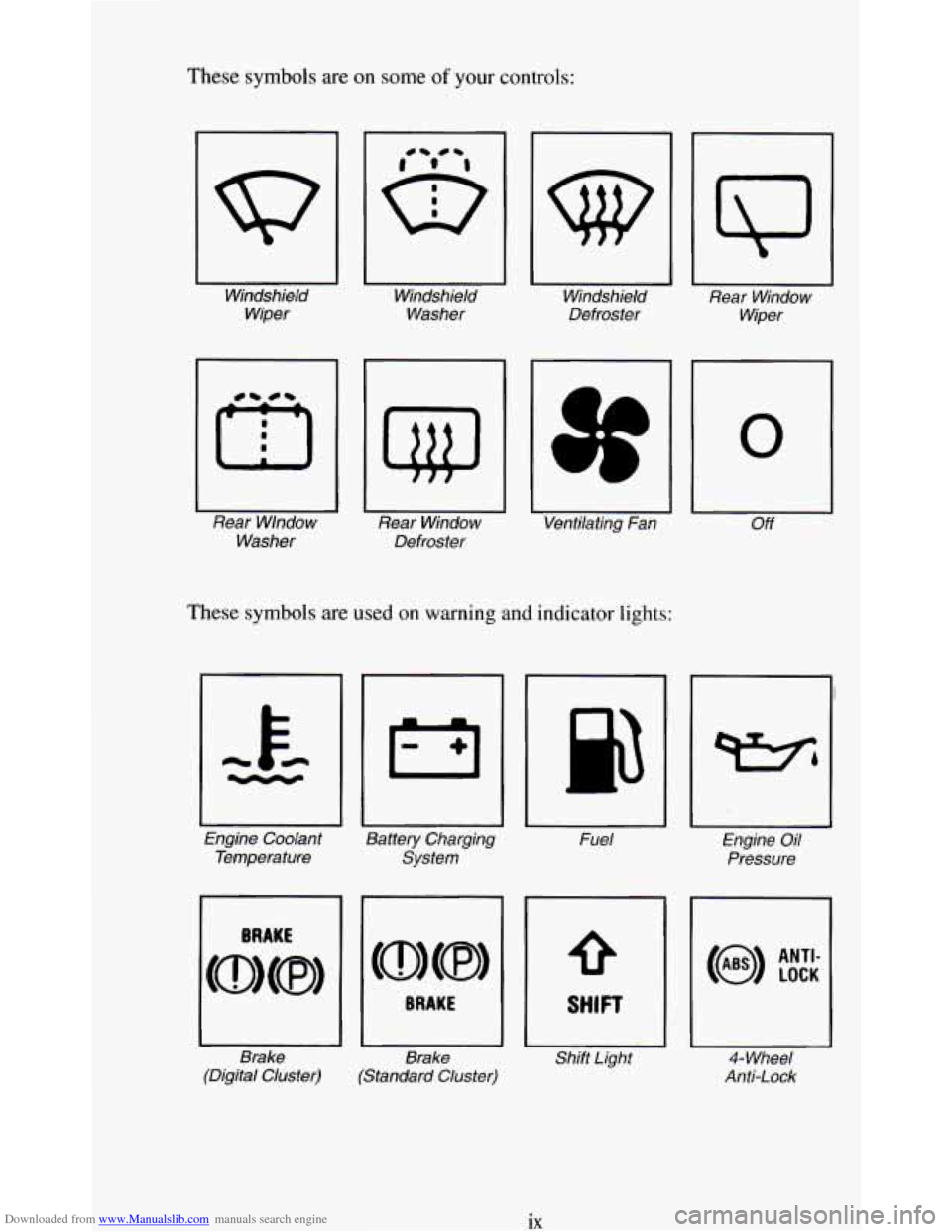
Downloaded from www.Manualslib.com manuals search engine These symbols are on some of your controls:
Windshield Windshield Windshield
Rear Window
Wiper Washer
Defroster
Wiper
Rear Wlndow Rear Window Ventilating Fan
Off
Washer Defroster
These symbols are usea on warning and indicator lights:
0
Engine Coolant
Battery Charging Fuel Engine Oil
Temperature System Pressure
Brake Brake Shift Light
4- Wheel
(Digital Cluster) (Standard Cluster) Anti-Lock
ix
Page 187 of 348
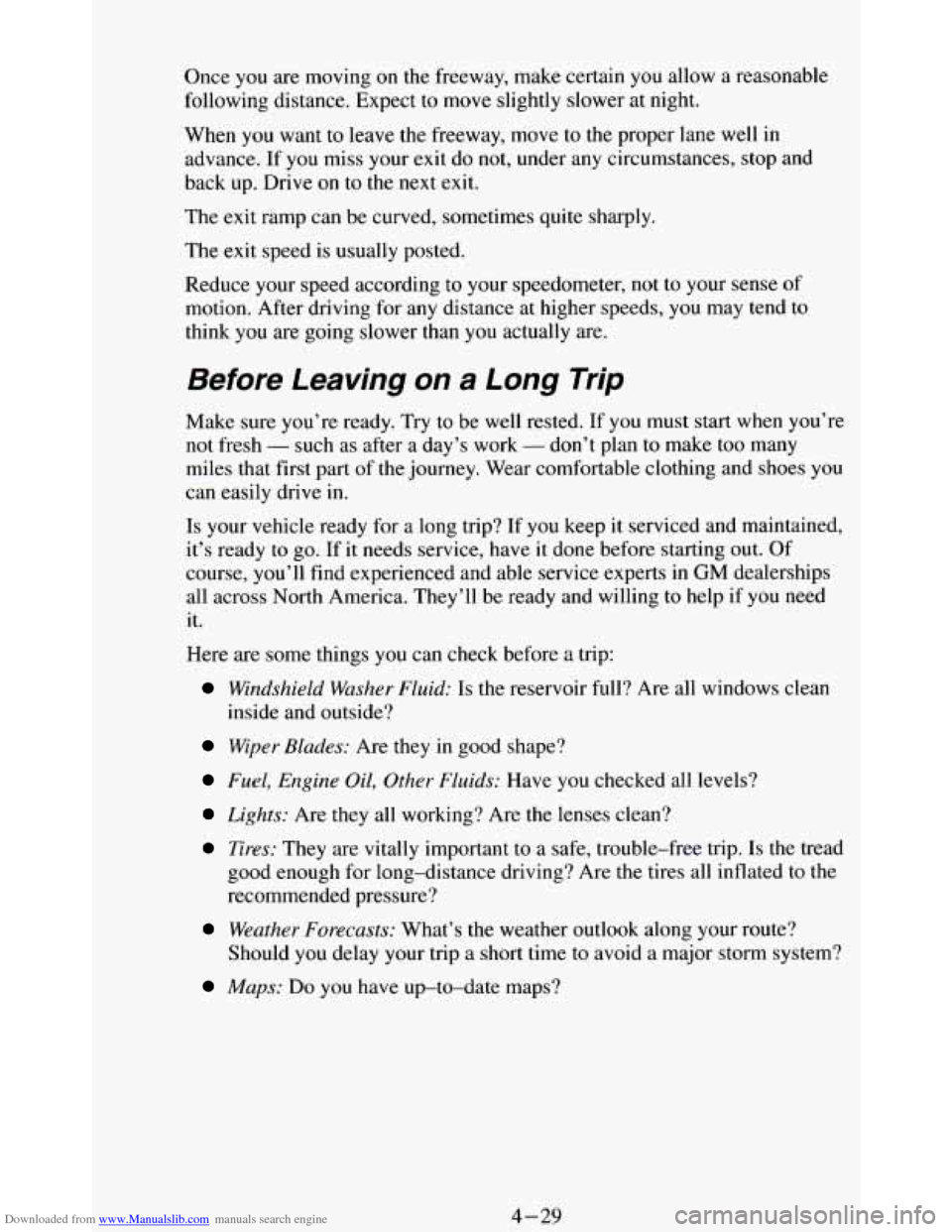
Downloaded from www.Manualslib.com manuals search engine Once you are moving on the freeway, make certain you allow a reasonable
following distance. Expect to move slightly slower at night.
When you
want to leave the freeway, move to the proper lane well in
advance. If you miss your
exit do not, under any circumstances, stop and
back up. Drive on to the
next exit.
The exit ramp can be curved, sometimes quite sharply.
The exit speed is usually posted.
Reduce your speed according to your speedometer, not
to your sense of
motion. After driving for
any distance at higher speeds, you may tend to
think
you are going slower than you actually are.
Before Leaving on a Long Trip
Make sure you’re ready. Try to be well rested. If you must start when you’re
not fresh
- such as after a day’s work - don’t plan to make too many
miles
that first part of the journey. Wear comfortable clothing and shoes you
can easily drive
in.
Is your vehicle ready for a long trip? If you keep it serviced and maintained,
it’s ready to
go. If it needs service, have it done before starting out. Of
course, you’ll find experienced and able service experts
in GM dealerships
all across North America. They’ll be ready and willing to help if you need
it.
Here are some things you can check before a trip:
Windshield Washer Fluid: Is the reservoir full? Are all windows clean
inside and outside?
Wiper Blades: Are they in good shape?
Fuel, Engine Oil, Other Fluids: Have you checked all levels?
Lights: Are they all working? Are the lenses clean?
Tires: They are vitally important to a safe, trouble-free trip. Is the tread
good enough for long-distance driving? Are the tires all inflated
to the
recommended pressure?
Weather Forecasts: What’s the weather outlook along your route?
Maps: Do you have up-to-date maps?
Should
you delay your trip
a short time to avoid a major storm system?
4-29
Page 275 of 348
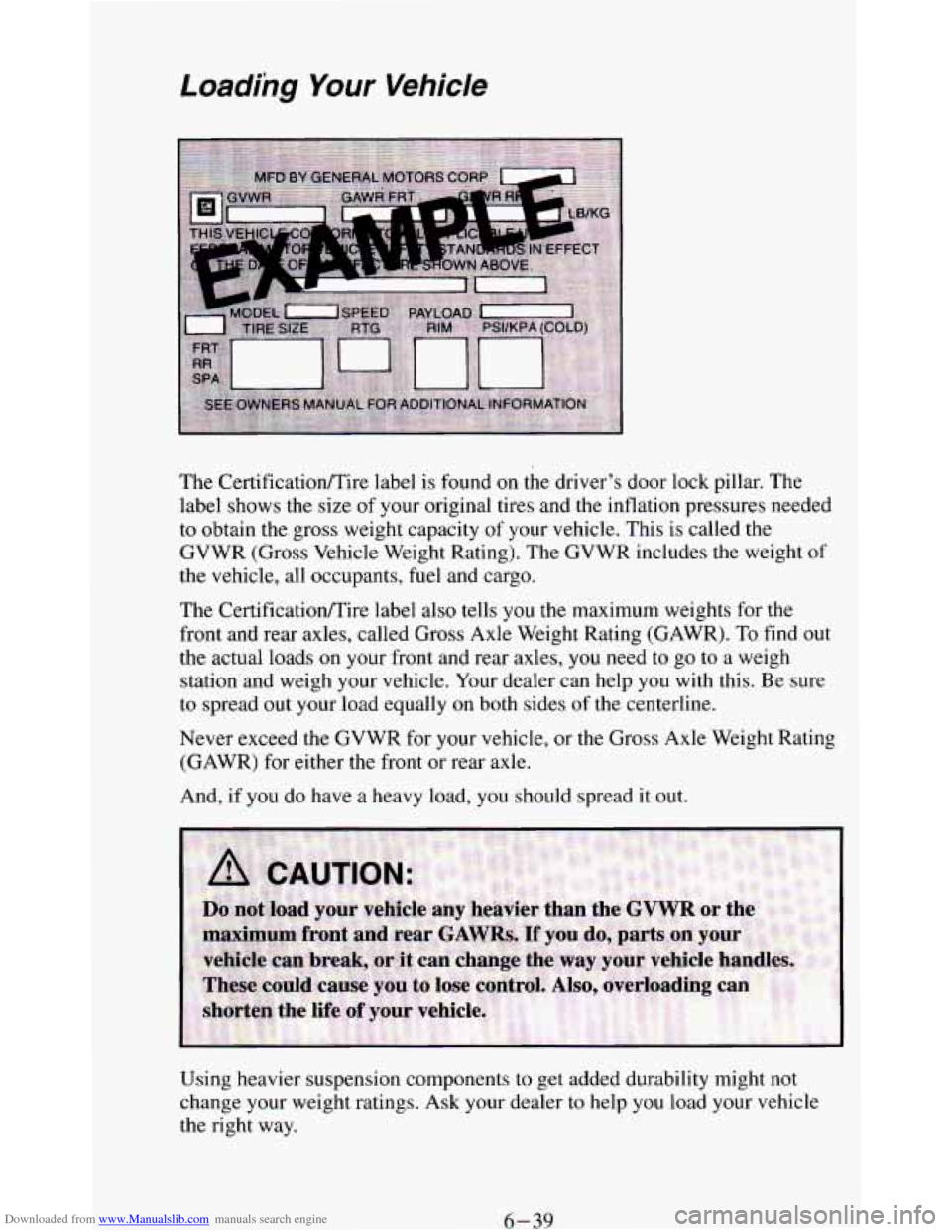
Downloaded from www.Manualslib.com manuals search engine Loading Your Vehicle
The CertificatiodTire label is found on the driver’s door lock pillar. The
label shows
the size of your original tires and the inflation pressures needed
to obtain the gross weight capacity
of your vehicle. This is called the
GVWR (Gross Vehicle Weight Rating). The GVWR includes the weight
of
the vehicle, all occupants, fuel and cargo.
The Certificationnire label
also tells you the maximum weights for the
front and rear axles, called Gross Axle Weight Rating (GAWR). To find
out
the actual loads on your front and rear axles, you need to go to a weigh
station and weigh your vehicle. Your dealer can help you with this. Be sure
to spread out your load equally on both sides
of the centerline.
Never exceed the GVWR for your vehicle, or the Gross Axle Weight Rating
(GAWR) for either the front or rear axle.
And, if you do have a heavy load, you should spread it out.
Using heavier suspension components to get added durability might not
change your weight ratings.
Ask your dealer to help you load your vehicle
the right way.
6-39
Page 279 of 348
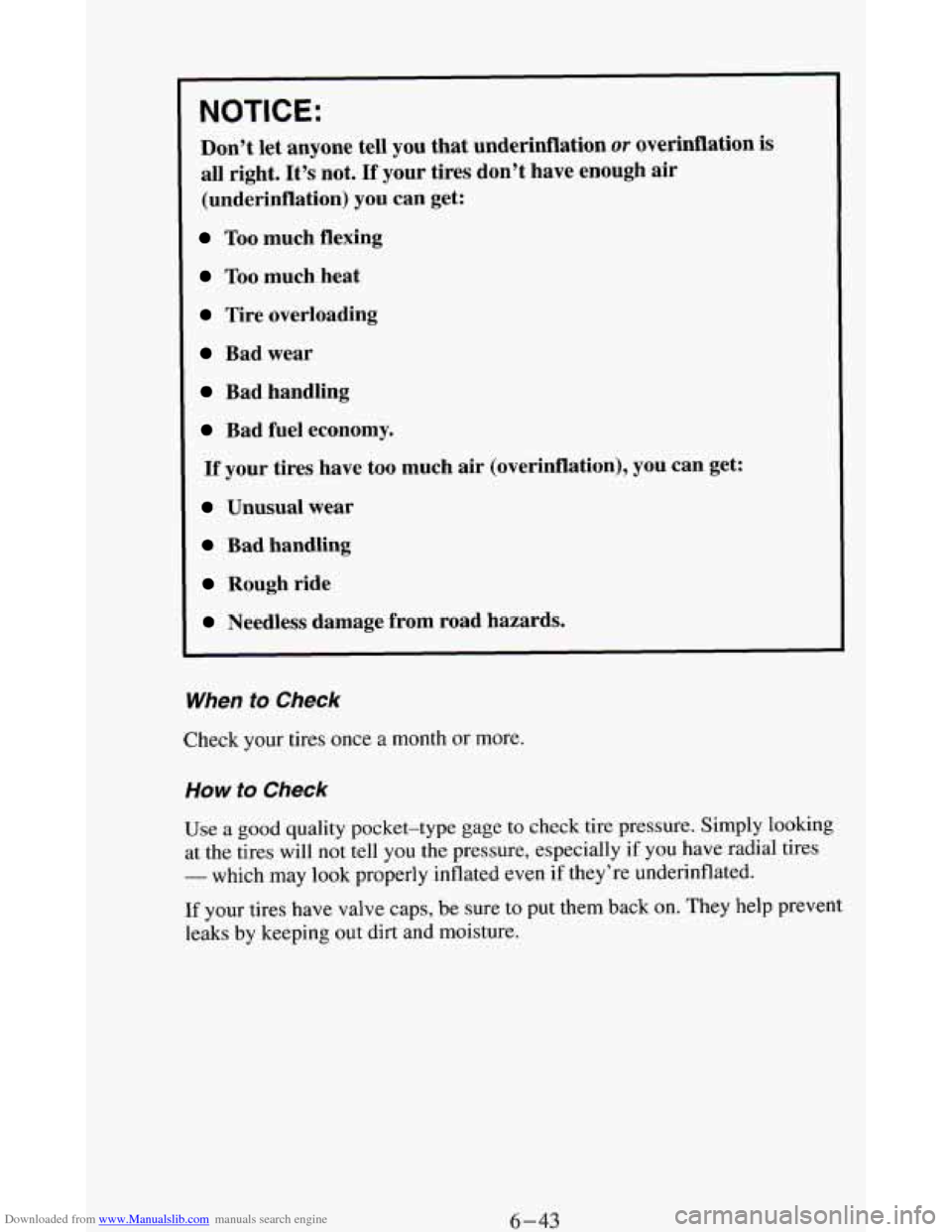
Downloaded from www.Manualslib.com manuals search engine NOTICE:
Don’t let anyone tell you that underinflation or overinflation is
all right. It’s not. If your tires don’t have enough air
(underinflation)
you can get:
Too much flexing
Too much heat
Tire overloading
Bad wear
Bad handling
Bad fuel economy.
If your tires have too much air (overinflation), you can get:
Unusual wear
Bad handling
Rough ride
Needless damage from road hazards.
When to Check
Check your tires once a month or more.
How to Check
Use a good quality pocket-type gage to check tire pressure. Simply looking
at the tires will not tell you the pressure, especially if you have radial tires
- which may look properly inflated even if they’re underinflated.
If your tires have valve caps, be sure to put them back on. They help prevent
leaks by keeping out dirt and moisture.
6-43
Page 317 of 348
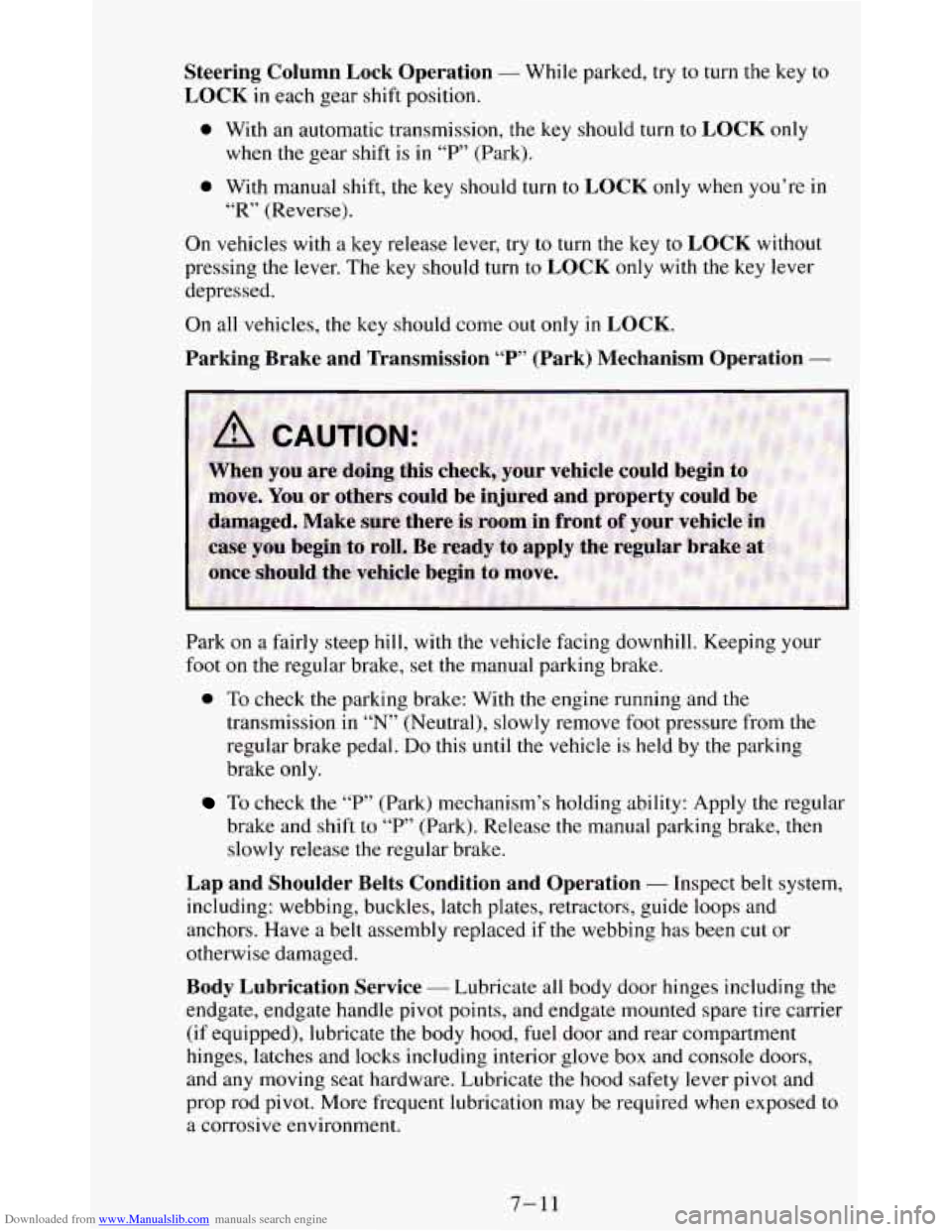
Downloaded from www.Manualslib.com manuals search engine Steering Column Lock Operation - While parked, try to turn the key to
LOCK in each gear shift position.
0 With an automatic transmission, the key should turn to LOCK only
0 With manual shift, the key should turn to LOCK only when you’re in
On vehicles with a key release lever, try to turn the key to
LOCK without
pressing the lever.
The key should turn to LOCK only with the key lever
depressed.
On all vehicles, the key should come out
only in LOCK.
Parking Brake and Transmission
“P’ (Park) Mechanism Operation -
when the gear shift is in “P’ (Park).
“R” (Reverse).
Park on a fairly steep hill, with the vehicle facing downhill. :eping your
foot on the regular brake, set the manual parking brake.
0 To check the parking brake: With the engine running and the
transmission in
“N’ (Neutral), slowly remove foot pressure from the
regular brake pedal.
Do this until the vehicle is held by the parking
brake only.
To check the “P” (Park) mechanism’s holding ability: Apply the regular
brake and shift to
“P” (Park). Release the manual parking brake, then
slowly release the regular brake.
Lap and Shoulder Belts Condition and Operation - Inspect belt system,
including: webbing, buckles, latch plates, retractors, guide loops and
anchors. Have a belt assembly replaced if the webbing has been cut or
otherwise damaged.
Body Lubrication Service - Lubricate all body door hinges including the
endgate, endgate handle pivot points, and endgate mounted spare tire carrier
(if equipped), lubricate the body hood,
fuel door and rear compartment
hinges, latches and locks including interior glove box and console doors,
and any moving seat hardware. Lubricate the hood safety lever pivot and
prop rod pivot. More frequent lubrication may be required when exposed
to
a corrosive environment.
7-11
Page 340 of 348
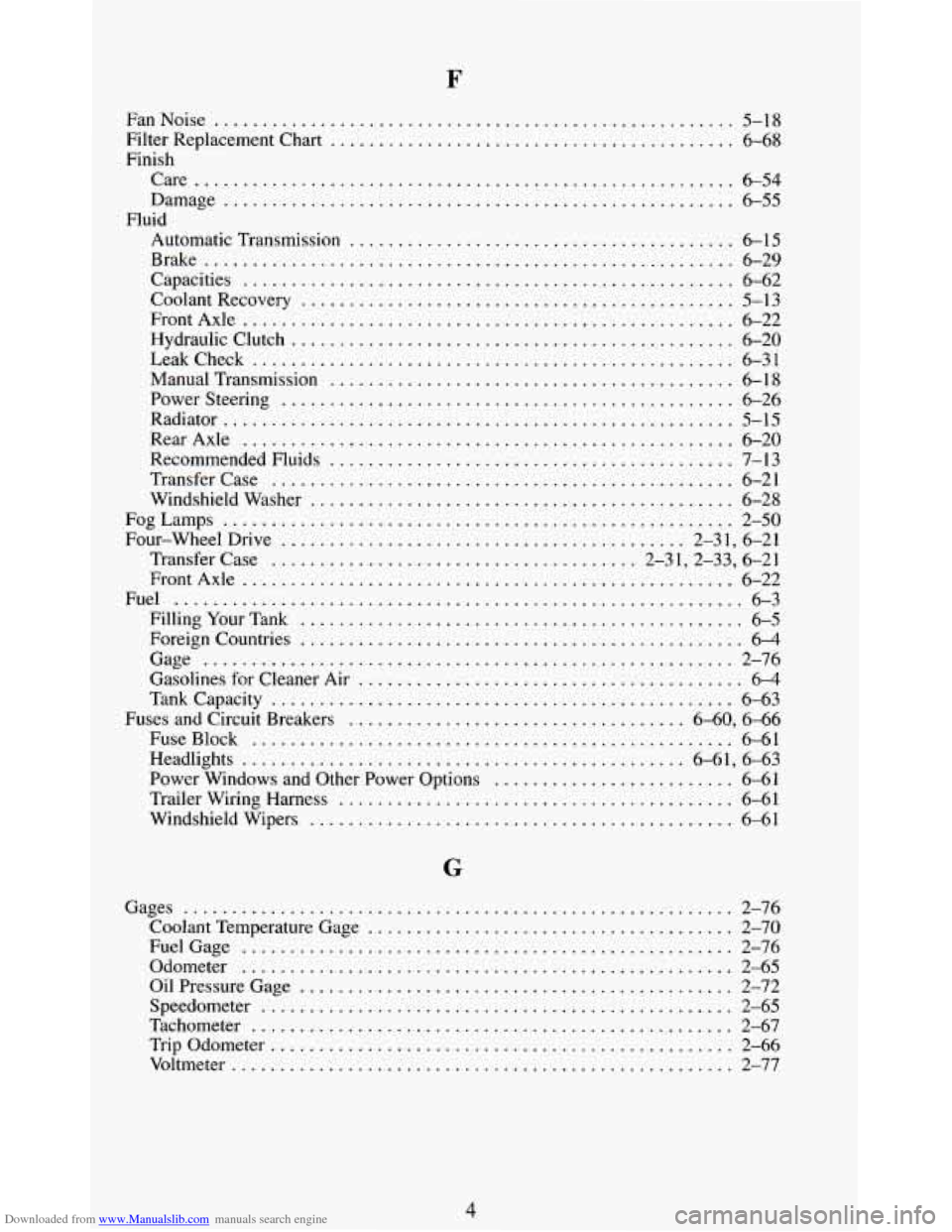
Downloaded from www.Manualslib.com manuals search engine FanNoise ...................................................... 5-18
Finish
Filter
Replacement Chart
.......................................... 6-68
Care
........................................................ 6-54
Damage ..................................................... 6-55
Automatic Transmission
........................................ 6-15
Brake
....................................................... 6-29
Capacities
................................................... 6-62
CoolantRecovery
............................................. 5-13
FrontAxle
................................................... 6-22
Leakcheck
.................................................. 6-31
ManualTransmission
.......................................... 6-18
Powersteering
............................................... 6-26
Radiator
..................................................... 5-15
RearAxle
................................................... 6-20
Recommended Fluids
.......................................... 7-13
Transfercase
................................................ 6-21
Windshield Washer ............................................ 6-28
FogLamps
..................................................... 2-50
Four-WheelDrive
.......................................... 2-31, 6-21
Transfer Case
...................................... 2-3 1,2-33, 6-21
FrontAxle
................................................... 6-22
Fuel
........................................................... 6-3
FillingYourTank
.............................................. 6-5
Fluid
Hydraulicclutch
.............................................. 6-20
Foreign Countries
.............................................. 6-4
Gage
....................................................... 2-76
Gasolines for Cleaner Air
........................................ 6-4
Tankcapacity
................................................ 6-63
Fuses and Circuit Breakers
................................... 6-60, 6-66
FuseBlock
.................................................. 6-61
Headlights
.............................................. 6-61, 6-63
Power Windows and Other Power Options
......................... 6-61
Trailer Wiring Harness
......................................... 6-61
Windshield Wipers
............................................ 6-61
Gages
......................................................... 2-76
FuelGage
................................................... 2-76
Odometer ................................................... 2-65
OilPressureGage
............................................. 2-72
Speedometer
................................................. 2-65
Tachometer
.................................................. 2-67
Trip Odometer
................................................ 2-66
Voltmeter
.................................................... 2-77
Coolant Temperature Gage ...................................... 2-70
4